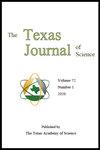PLAYA DYNAMICS AND SALINITY: A STUDY OF YELLOW LAKE ON THE HIGH PLAINS OF TEXAS
Q4 Agricultural and Biological Sciences
引用次数: 0
Abstract
Saline playas on the Southern High Plains are almost always located on large cattle ranches but they are of limited value to the herds of cattle grazing around their outer margins. Saline playas are often without water for extended periods and, after inundation, they experience considerable evaporative loss leading to hypersaline conditions. The primary goal of this study was to develop a quantitative method that combines the transitory nature of playa lakes and the variability of salinity into a set of parameters that can be used to compare playas or other surface water sources. Regarding water quality, a variable was developed that describes the fraction of observations with salinity levels below the salt tolerance threshold for cattle. With regard to water availability, water depth measurements were used to compute the fraction of time that a playa contains water. These two variables are combined to form a new variable that represents the fraction of time that water is both available and of acceptable quality. To demonstrate the utility of this method, data was collected at Yellow Lake, a large saline playa located on the Yellow House Ranch northwest of Lubbock, Texas. Results suggest that the playa contained water 50.8% of the time over a five-year period but the fraction of water samples with acceptable salinity was only 6.5%. The resulting fraction of time that water was both available and of acceptable quality was only 3.3%. This technique could be used to compare other ephemeral surface water sources in the region.普拉亚动力学与盐度:德克萨斯州高平原黄湖的研究
南部高平原上的盐碱地几乎总是位于大型牧场上,但对在其外缘放牧的牛群来说,它们的价值有限。盐碱地通常长时间无水,淹没后,它们会经历相当大的蒸发损失,导致高盐度条件。这项研究的主要目标是开发一种定量方法,将普拉亚湖的短暂性和盐度的可变性结合成一组参数,用于比较普拉亚湖或其他地表水源。关于水质,开发了一个变量,描述了盐度低于牛耐盐阈值的观测分数。关于水的可用性,水深测量被用来计算操场含水的时间分数。这两个变量结合在一起形成了一个新的变量,该变量表示水既可用又具有可接受质量的时间分数。为了证明这种方法的实用性,在黄湖收集了数据,这是一个位于德克萨斯州拉伯克西北部黄屋牧场的大型盐碱地。结果表明,在五年的时间里,playa有50.8%的时间含有水,但具有可接受盐度的水样的比例仅为6.5%。由此产生的水既可用又具有可接受质量的时间比例仅为3.3%。这项技术可用于比较该地区的其他短暂地表水源。
本文章由计算机程序翻译,如有差异,请以英文原文为准。
求助全文
约1分钟内获得全文
求助全文
来源期刊

The Texas Journal of Science
Agricultural and Biological Sciences-Ecology, Evolution, Behavior and Systematics
CiteScore
0.50
自引率
0.00%
发文量
2
期刊介绍:
Scholarly manuscripts reporting original research results in any field of science or technology, including science education, will be considered for publication in The Texas Journal of Science. Prior to acceptance, each manuscript will be reviewed by both knowledgeable peers and the editorial staff. Authors are encouraged to suggest the names and addresses of two potential reviewers to the Manuscript Editor at the time of submission of their manuscript.
 求助内容:
求助内容: 应助结果提醒方式:
应助结果提醒方式:


